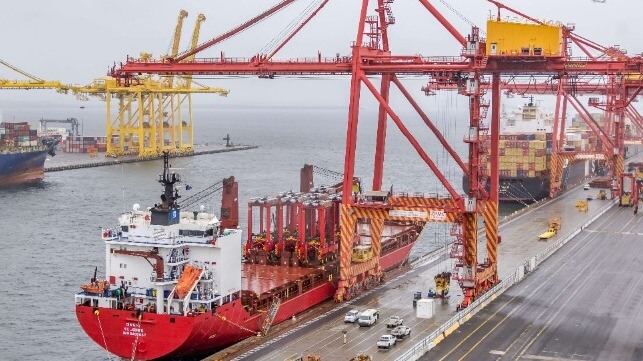Supply Chain Disruptions Continue to Plague Australian Container Ports

According to a report from the Australian Competition and Consumer Commission (ACCC), the COVID-19 pandemic, and other developments, have continued to cause significant congestion and delays in the container freight supply chain in Australia throughout 2021–22. The report cited three factors that have exacerbated these effects: low shipping schedule reliability, increased size of ships calling Australian container ports, and labor shortages throughout the supply chain.
Stevedores have informed the ACCC that low vessel schedule reliability is a critical factor contributing to congestion and has resulted in ‘vessel bunching’ at ports. While global schedule reliability improved over 2022, it remains well below pre-pandemic levels. This creates significant peaks and troughs for stevedores in handling containers.
There has been a longer-term trend towards larger ships in container shipping globally. The proportion of port calls made by ships with gross tonnage above 80,000 at Australian container ports has increased from 3.8 percent in 2018–19 to 14.3 percent in 2021–22. Servicing these larger ships presents more operational challenges and further amplifies the peaks and troughs throughout the container supply chain.
The report stated that some market participants raised concerns about staff availability throughout 2021–22 due to sickness or isolation requirements. This has been worsened by broader labor shortages throughout the supply chain, with stevedores finding it challenging to identify appropriate new hires and retain them long enough to develop skills and industry knowledge. In particular, the shortage of truck drivers has contributed to increased congestion at some storage facilities and empty container parks.
These delays at the ports have led to some importers preferring to hold higher inventory levels, moving from a ‘just-in-time’ to a ‘just-in-case’ business model. This puts further pressure on the supply chain and has increased demand for warehousing space, driving higher rents.

that matters most
Get the latest maritime news delivered to your inbox daily.
All these factors contributed to ongoing congestion in the supply chain, sometimes overwhelming its capacity to unload efficiently, transport, process, unpack and return containers. Stevedores stated that it had been more challenging for them to allocate labor and equipment, resulting in stevedores taking longer to move containers to and from ships.
Despite these challenges, there are signs of improvement. It is estimated that global container port congestion has halved between January and August 2022.
